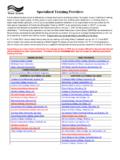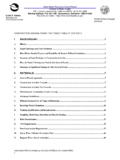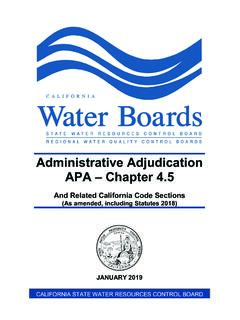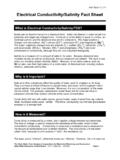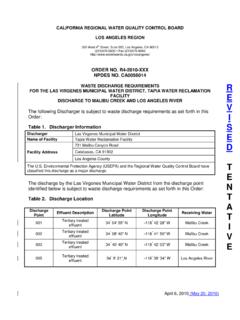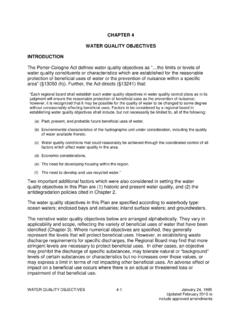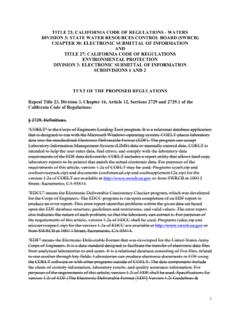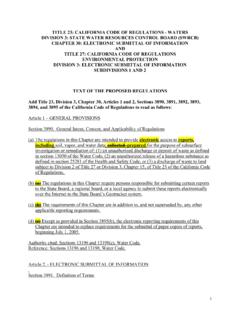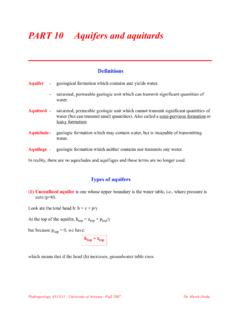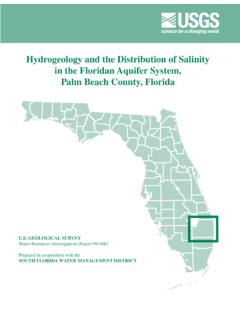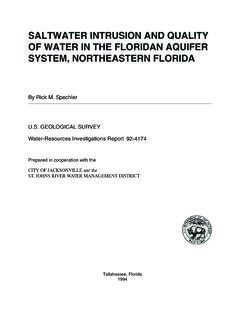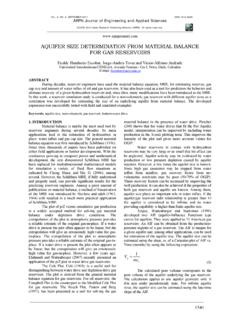Transcription of Aquifer Exemption Checklist
1 Aquifer Exemption Checklist Reviewed by: _____ .Date ___ _ A-Regulatory Background and Purpose An Aquifer or a portion thereof which meets the criteria for an "underground source of drinking water" in may be determined to be an "exempted Aquifer ". The Aquifer Exemption criteria at must be met as follows: Class 1-V wells must meet criteria (a) and (b)(l); or (a) and (b)(2); or (a) and (b)(3); or (a) and (b)(4); or (a) and (c). Class VI wells must meet the criteria (d)1. Regardless of t he AE request or the type of injection act ivity, i n all cases, first and foremost a demonstration that the Aquifer or portion thereof does not currently serve as a source of drinking water is the required first step in the process. EPA must evaluate each AE request to ensure the criteria are met prior to approval. EPA should also document its rationale for approving or disapproving each AE request in its statement of basis and, in case of exemptions that are substantial program revisions, EPA must p rovide public notice and an opportunity for the public to comment and request a public hearing.
2 The purpose of this Checklist is to ensure that appropriate and adequate information is collected to facilitate review of AE requests, and documentation of AE decisions. Some information described here may not apply to all AE requests. B-General Information AE request received by EPA on------------Is the Aquifer Exemption Substantial Non-Substantial. _____ _ Describe basis for substantial/non-substantial determination. _____ _ Is the Aquifer Exemption Complex? (Existence of drinking water wells, populated area .. ) -----------Did the state or tribe provide public notice and opportunity for public hearing on the Aquifer Exemption request ( (b)) Y/N Were there any public comments? Y /N If yes, identify where they may be located. _____ _ Date(s) of notice(s) published Public meeting(s) held Heari ng held -------'any notable findings or pending litigation---------------------Describe the notice and comment process and the final decision. _____ _ Describe the basis for the decision to exempt the Aquifer or the basis for the decision to withhold or deny approval of the exemptions request ----------------------------------Any anticipated issues associated with EPA approval or disapproval of the AE request Y/N _____ ___ Any meetings between EPA/States/Tribes/Operator t o discuss issues Y /N list _____ _ Is the request submitted by a primacy state or tribe?
3 Y/N If yes name the State/Tribe/Agency ____ Contact.:..:-----------------------AE identified by the Primacy State or tribe and submitted for EPA review and final determination on -------Name of the Owner/operator _____ _ Well/Project Name ..:..:--------------------Well Class------------Purpose of injection: (mineral mining/oil and gas/other) Where is the proposed Aquifer Exemption located? Township, Section, Range, Quarter Section or other method used to identify the area latitude and longitude information County City ____ _ State Add informat ion about distance to nearest Town, County----------------Name of Aquifer or portion of Aquifer to be exempted------------------------1 Additional Class VI only requirements in 40 CFR (d)( I) and (2) apply. This Checklist does not address those requirements. Areal extent of the area proposed for Exemption _____ _ Depth and thickness of t he Aquifer -------------------------------Di scuss the total dissolved so lid (TDS) content of the Aquifer , including t he TDS at t he top and bottom of the exempted zone, and the locations and depths of all fl uids samples Criteria : An Aquifer or a por tion thereof may be determined to be an exempted Aquifer for Class 1-V wells if it meets the criteria in paragraphs (a) -(c) below.
4 Other than EPA approved Aquifer Exemption expansions that meet the criteria set forth in (d), new Aquifer exemptions for Class VI wells shall not be issued. ) (a} Not currently used as a drinking water source and: ) (b}(l} It is min eral, hydrocarbon, or geothermal energy producing, or can be demonstrated by a permit applicant as part of a permit applicat ion for a Class II or Class II operation to contain minerals or hydrocarbons t hat considering t heir quant ity and location are expected to be commercia lly producible; or ( ) (b}(2} It is sit uat ed at a depth or location which makes recovery of wat er fo r drinking water purposes economically or t echnologically impractical; or ( ) (b}(3) It is so cont aminated that i t would be economically or technologically impractical t o render that wat er fit for human consumpt ion; or ( ) (b}(4} It is locat ed over a Class Ill well mining area subject to subsidence or cat astrop hic collapse; or ( ) (c) TDS is more than 3,000 and less than 10,000 mg/1 and it is not reasonably expected to supply a p ublic water system.))))))
5 ( ) (d) The areal extent of an Aquifer Exemption for a Class II enhanced oil recovery or enhanced gas recovery well may be expanded for the exclusive purpose of Class VI injection for geologic sequestration under 144. l(d) if i t does not currently serve as a source of drinking water; and the TDS is more than 3,000 mg/1 and less than 10,000 mg/1; and it is not reasonably expected to supply a public water system. 1-Demonstration that the Aquifer or portion thereof does not currently serve as a source of drinking water per (a) Descr ibe the proposed exempted area and how it was determined: _____ _ TDS: _____ Top: _____ _ Bottom: _____ _ Lithology:------------------------------ --------Permeability: Porosity: Groundwater flow direction: -------------Upper and Lower Confining Zone(s} and description of vertical confinement from USDWs: Are there any public or private drinking water wells within and nearby the proposed exempted area for which the proposed exempted portion of the Aquifer might be a source of drinking water Y / N If yes, list all those wells Include: pertinent map(s) visually showing the areal extent of Exemption boundary, depth and thickness of the Aquifer proposed for Exemption , all known subsurface structures such as faults affecting the Aquifer , and each of the inventoried water well locations by w ell # or owner name.)
6 Include: Table of all inventoried water wells showing: Well Name/#, Owner, (Private/Public), Contact information, Purpose of well (Domestic, Irrigation, Livestock, et c.), depth of source water, name of Aquifer , well co mpletion data, age of well (if known), and the primary source of well dat a (Applicant/State/Tribe/EPA). Include: Map showing the areal extent of Exemption boundary, all domestic wat er wells considered potentially down gradient of t he Exemption and hydraulically connected to the Exemption . If wells are deemed horizontally and/or vertically isolated from the Exemption , this should be foot noted on t he Table as w ell. Use arrow (s) to indicate t he direction and speed of GW in t he Aquifer proposed for Exemption . Describe the evidence presented in t he application and/or methodology used to conclude GW direction and speed when relevant. Include: any source water assessment and/or protection areas and designated sole source aquifers located w ithin the delineated area.
7 What is the appropriate area to examine for drinking water wells? Although guidance 34 says it should be a minimum of 1/4 mile, the determination of the appropriate area is on a case by case basis. Describe area and give a rationale. Are there any public or private drinking water wells or springs capturing (or that will be capturing) or producing drinking water from the Aquifer or portion thereof within the proposed Exemption area? Y /N"' Evaluate the capture zone of the well (s) in the area near the proposed project ( , the volume of the Aquifer (s) o r portion(s) thereof from within which groundwater is expected to be captured by that well). A drinking water well' s current source of water is the volume (or portion) of an Aquifer which contains water that w ill be produced by a well i n its lifetime. What parameters were considered to determine the lifetime of the well? (*) If the answer to this question is Yes, t herefore the Aquifer currently serves as a source of drinking water. 2-Demonstration that the Aquifer or portion thereof is mineral, hydrocarbon or geothermal energy producing per (b)(l) Did the permit applicant for a Class II or Ill operation demonstrate as part of the permit application that the Aquifer or portion thereof contains minerals or hydrocarbons that, considering their quantity and location are expected to be commercially producible?
8 Did the permit applicant furnish the data necessary to make the demonstration as required by 40 {c)(1) and (2}? Summarize this demonstration and data----------------Include narrative statem ent, logs, maps, data and state issued permit. If the proposed Exemption is to allow a Class II enhanced oil recovery well operation in a field or project containing aquifers from which hydrocarbon were previously produced, commercial producibility shall be presumed by the Director upon a demonstration of historical production having occurred in the project area or field. M any times it may be necessary to slightly expand an existing Class II operation to recover hydrocarbons and an Aquifer Exemption for the expanded area may be needed. If the expanded Exemption for the Class II EOR well is for a well field or project area where hydrocarbons were previously produced, commercial producibility would be presumed. For new or existing Class II wells not located in a field or project containing aquifers from which hydrocarbons were previously produced, information such as logs, core data, formation description, formation depth, formation thickness and formation parameters such as permeability or porosity shall be considered by the Director, to the extent available.
9 Many Class II inj ection well permit applicants may consider much information concerning production potential to be proprietary. As a matter of policy, some states/tribes do not allow any information submitted as part of a permit application to be confid ential. In those cases where potential production information is not being submitted, EPA would need some record basis for concluding that the permit application demonstrates that the Aquifer contains commercially producible minerals or hydrocarbons. For example, the permit application may include the results of any R & D pilot project. In this case, the applicant should state the reasons for believing that there are commercially producible quantities of minerals within the expanded area. Also, exemptions relating to new or existing Class II wells not located in a field o r project containing aquifers from which hydrocarbons were previously produced should include the following t ypes of information: a-Production history of t he w ell if it is a former production well which is being converted.
10 B-Description of any drill stem tests run on the horizon in question. This should include information on the amount of oil and water produced during the test c-Production history of other wells in the vicinity which produce from the horizon in question. d-Description of the project, if it is an enhanced recovery operation including the number of wells and there location. For Class Ill wells, the Director must require an applicant to furnish data necessary to demonstrate that the Aquifer is expected to be mineral or hydrocarbon producing and the Director must consider information contained in the mining plan for the proposed p roject, such as a map and general description of the mining zone, general information on the mineralogy and geochemist ry of the mining zone, analysis of t he amenability of the mining zone to the proposed mining method, and a time-table of planned development of the mining zone. Information to be provided may also include: a summary of logging which indicates t hat commercially producible quantities of minerals or hydrocarbons are present.
